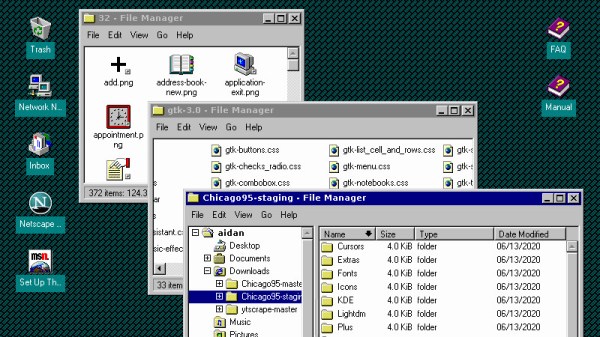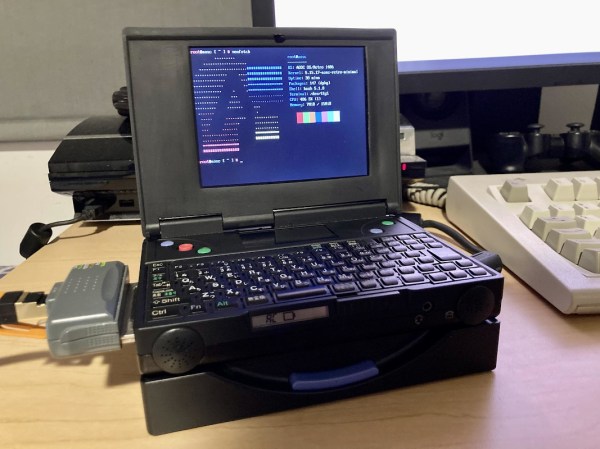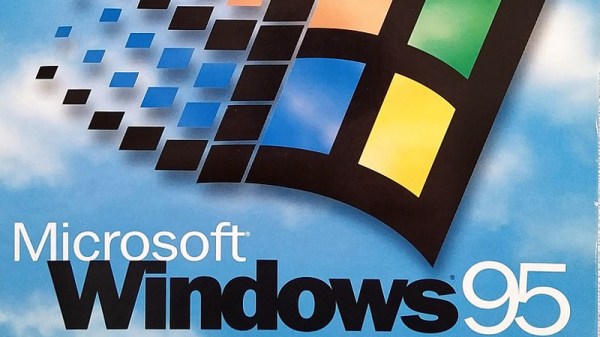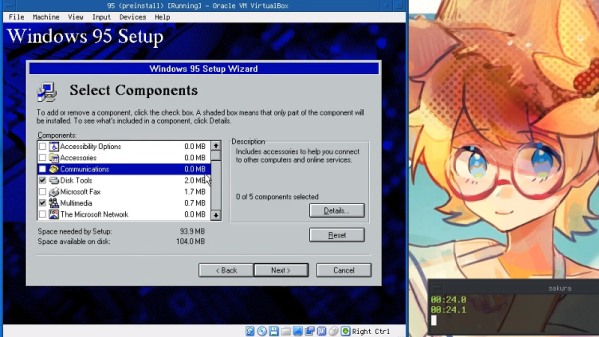There are plenty of stories floating around about the war in Ukraine, and it can be difficult to sort out which ones are fact-based, and which are fabrications. Stories about the technology of the war seem to be a little easier to judge, and so stories about an inside look at a purported Russian drone reveal a lot of interesting technical details. The fixed-wing UAV, reported to be a Russian-made “Orlan,” looks quite the worse for wear as it’s given a good teardown by someone wearing Ukraine military fatigues. In fact, it looks downright homemade, with a fuel tank made from what looks like an old water bottle, liberal use of duct tape to hold things together, and plenty of hot glue sprinkled around — field-expedient repairs, perhaps? The big find, though, is that the surveillance drone carried a rather commonplace — and cheap — Canon EOS Rebel camera. What’s more, the camera is nestled into a 3D printed cradle, strapped in with some hook-and-loop tape, and its controls are staked in place with globs of glue. It’s an interesting collection of hardware for a vehicle said to cost the Russian military something like $100,000 to field. The video below shows a teardown of a different Orlan with similar results, plus a lot of dunking on the Russians by a cheery bunch of Ukrainians.
windows 9515 Articles
Where Do You Want To Go Today? Perhaps To A Linux With A Familiar Interface?
Sometimes we cover works of extreme technological merit here at Hackaday, other times we cover interesting projects that while they might not lie at the bleeding edge are interesting enough that they deserve a wider audience. Sometimes though, we bring you something in this field simply because it amuses us and we think it will you too. Such is the case with [Bryan Lunduke]’s look at making a Linux desktop look like Windows 95. And lest you think that it might be yet another skin to make Windows users transition to Linux a bit easier, the aim and result is to make it look exactly like Microsoft’s mid-90s desktop.
Underneath it all is the relatively familiar xUbuntu distribution, with a deliciously troll-worthy project called Chicago95 atop it. This takes some existing Windows 95 theme and icon projects, and adds GTK themes, an MS-DOS shell theme, the ability to install those cheesy ’90s Plus! themes, and a Microsoft Office 95 theme for LibreOffice. It really does deliver an experience very close to the Redmond original.
So, what’s the point here in 2022? In the first instance it’s an excellent opportunity to troll open-source enthusiast friends with a crusty laptop seemingly running ’95 and showing YouTube videos on Netscape Navigator 3. But beyond the jokes there is a serious use for it. There may be many criticisms that can be leveled at Windows 95, but it’s safe to say that its GUI was a significant success whose echoes can be found in many desktops here in 2022. There are a huge number of people in the world who are completely at home in a Windows 95 environment who might struggle with a Linux desktop, and this gives them a way to be immediately productive. Would you give your grandmother a Linux box with this desktop?
IBM PalmTop Running Modern (Modified) Linux
The handheld computing market might seem dominated by smartphones today, but before their mass adoption there were other offerings for those who needed some computing power on-the-go. If a 90s laptop was too bulky, there was always the IBM PalmTop which packed punch for its size-to-weight ratio, and for the era it was created in. [Mingcong Bai] still has one of these antiques and decided to see if it was still usable by loading a customized Linux distribution on it.
The PalmTop sported modest hardware even for its time with an Intel 486SL running at 33 MHz with 20 MiB of RAM. This one also makes use of a 1 GB CompactFlash card for storage and while [Mingcong Bai] notes that it is possible to run Windows 95 on it, it’s not a particularly great user experience. A Linux distribution customized for antique hardware, AOSC/Retro, helps solve some of these usability issues. With this it’s possible to boot into a command line and even do some limited text-based web browsing as long as the Ethernet adapter is included.
While the computer is running at its maximum capacity just to boot and perform basic system functions, it’s admirable that an antique computer such as this still works, especially given its small size and limited hardware functionality. If you’re curious about more PalmTop-style computers, take a look at the first one ever produced: the HP-200LX.
Continue reading “IBM PalmTop Running Modern (Modified) Linux”
Start Me Up: What Has The Windows 95 Desktop Given Us 25 Years Later?
We’ve had something of an anniversary of late, and it’s one that will no doubt elicit a variety of reactions from our community. It’s now 25 years ago that Windows 95 was launched, the operating system that gave the majority of 1990s PC users their first taste of a desktop-based GUI and a 32-bit operating system.
To the strains of the Rolling Stones’ Start me up, Microsoft execs including Bill Gates himself jubilantly danced on stage at the launch of what was probably to become the company’s defining product, perhaps oblivious to the line “You make a grown man cry” which maybe unwittingly strayed close to the user experience when faced with some of the software’s shortcomings.
Its security may seem laughable by the standards of today and the uneasy marriage of 16-bit DOS underpinning a 32-bit Windows operating system was clunky even in its heyday, but perhaps now is the best time to evaluate it unclouded by technical prejudice. What can we see of Windows 95 in the operating systems we use today, and thus from that can we ask the question: What did Windows 95 get right? Continue reading “Start Me Up: What Has The Windows 95 Desktop Given Us 25 Years Later?”
Speedrunning Windows 95
Speedrunning is the practice of attempting to beat a videogame in as short a time as possible. There are a huge variety of methods and styles. There are 100% completion speedruns, tool-assisted speedruns, and speedruns that just focus on getting to the game over screen as quickly as possible by hook or by crook. Now, there’s a world record speedrun, installing Windows 95B in just 1 minute 10.9 seconds.
The current best attempts are collected in a Google Sheets document. So far, there have been few competitors but we expect to see more activity in future. The current rules for world record competition require original floppy and CD-ROM images to be used, but there are no limits on hardware, so records should tumble as time goes on. All the top times have been completed in virtual machines, but we’d love to see an attempt made on raw hardware.
It all kicked off when [oscareczek] grew tired of trying to compete in traditional gaming speedruns, so invented a new category instead. Competition has already come a long way from that original 4 minute time, and competitors are now considering advanced techniques such as RAM disks to speed their runs. All keystrokes are by hand at the moment, but we could see a tool-assisted competition starting up in future.
We’ve seen speedrunning techniques pushed to impressive limits before – like running Pong within Super Mario World, just for fun. Video after the break.
Microsoft Live Account Credentials Leaking From Windows 8 And Above
Discovered in 1997 by Aaron Spangler and never fixed, the WinNT/Win95 Automatic Authentication Vulnerability (IE Bug #4) is certainly an excellent vintage. In Windows 8 and 10, the same bug has now been found to potentially leak the user’s Microsoft Live account login and (hashed) password information, which is also used to access OneDrive, Outlook, Office, Mobile, Bing, Xbox Live, MSN and Skype (if used with a Microsoft account).
Continue reading “Microsoft Live Account Credentials Leaking From Windows 8 And Above”
Windows 95 On An Apple Watch
What happens if the slick user interface and tight iOS integration of your Apple Watch leave you wanting more? A real operating system, from the days when men were men and computers were big grey boxes!
[Nick Lee] solved this unexpected problem with his Watch by getting a working copy of Windows 95 to run on it. On paper it shouldn’t be at all difficult, with a 520 MHz ARM, 512 MB of RAM, and 8GB of storage you might think that it would eclipse the quick 486s and low-end Pentiums we ran ’95 on back in the day with ease. But of course, the ability to run aged Redmond operating systems on a Watch was probably not at the top of the Apple dev team’s feature list, so [Nick] had to jump through quite a few hoops to achieve it.
As you might expect, the ’95 installation isn’t running directly on the Watch. In the absence of an x86 processor his complex dev process involved getting the Bochs x86 emulator to compile for the Watch, and then giving that a ’95 image to boot. The result is comically slow, with a 1-hour boot time and a little motor attached to the Watch to vibrate it and stop it going to sleep. It’s not in any way a useful exercise, after all who’d really want to use ’95 on a Watch? Internet Explorer 3 and The Microsoft Network, how handy! But it’s one of those “because you can” exercises, and we applaud [Nick] for making it happen. If you want to give it a try, his Bochs-forWatchOS code is on Github.
The video below the break shows the process of booting the ’95 Watch, opening the Start Menu, and running one of the card games. One can almost feel the lengthening shadows outside as it goes.


















